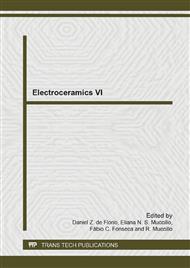p.173
p.179
p.184
p.189
p.194
p.201
p.207
p.213
p.219
A Capacitive-Type Humidity Sensor Using Porous Ceramics for Environmental Monitoring
Abstract:
The growing interest for the environmental monitoring in order to minimize the potential risk of landslide in hillsides and to prevent new disasters, has led the improvement in the development of new materials for manufacturing of capacitive sensor devices more reliable, more versatile and at lower cost. In this sense, ceramics have shown advantages from the point of view of mechanical resistance, resistance to chemical attacks and physical and chemical stability in aggressive environments. In addition, these materials have a unique structure, consisting of grains, grain boundaries, surfaces and pores, the control of which permit the attainment of suitable microstructures to be used as moisture sensors. The goal of this work is to investigate the capability of porous ceramics sensor devices, developed in National Institute of Space Research (INPE), to monitor the soil water dynamics. For that, ceramics sensors microstructures were characterized through scanning electron microscopy (SEM), X-ray diffractometry (XRD) and Hg porosimetry techniques. Electrical measurements were performed in function of water addition in soil samples, up to the saturation limit, for different time intervals, in the same way it happens in area with landslide risk in periods of rain. The analyses of the results evidenced that the ceramics devices are promising ones concerning to their potential in the monitoring of environmental parameters.
Info:
Periodical:
Pages:
194-198
Citation:
Online since:
July 2014
Price:
Сopyright:
© 2014 Trans Tech Publications Ltd. All Rights Reserved
Share:
Citation:


